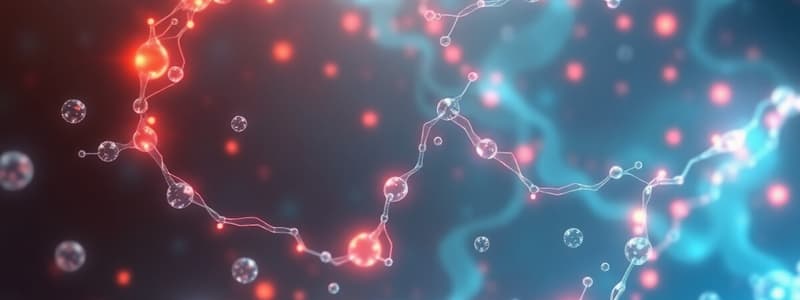Podcast
Questions and Answers
What is the primary consequence of low pH in muscle cells during exercise?
What is the primary consequence of low pH in muscle cells during exercise?
- It inhibits enzyme activity such as PFK. (correct)
- It promotes ATP hydrolysis.
- It activates lactate production.
- It enhances myosin-actin binding.
Which process is responsible for converting pyruvate to lactate in muscle cells?
Which process is responsible for converting pyruvate to lactate in muscle cells?
- Phosphocreatine metabolism.
- Myosin ATPase conversion.
- Creatine kinase facilitation.
- Lactate dehydrogenase (LDH) activation. (correct)
What adaptation to training is linked to improved lactate clearance?
What adaptation to training is linked to improved lactate clearance?
- Raised anaerobic threshold. (correct)
- Reduced mitochondrial levels.
- Increased lactate production.
- Decreased capillary density.
During muscle contraction, what is the role of calcium?
During muscle contraction, what is the role of calcium?
Which factor contributes to muscle fatigue during intense exercise?
Which factor contributes to muscle fatigue during intense exercise?
What is one of the implications of using beta-blockers in athletes?
What is one of the implications of using beta-blockers in athletes?
What is a potential consequence of lactic acid formation during intense exercise?
What is a potential consequence of lactic acid formation during intense exercise?
Which of the following methods does NOT enhance athletic performance?
Which of the following methods does NOT enhance athletic performance?
In which type of exercise is the oxidative capacity expected to increase significantly?
In which type of exercise is the oxidative capacity expected to increase significantly?
What effect does prolonged lactate production have on the body during exercise?
What effect does prolonged lactate production have on the body during exercise?
What primarily causes acute pain in muscles?
What primarily causes acute pain in muscles?
What is the main characteristic of Delayed-Onset Muscle Soreness (DOMS)?
What is the main characteristic of Delayed-Onset Muscle Soreness (DOMS)?
Which process is primarily utilized during fasting to maintain energy?
Which process is primarily utilized during fasting to maintain energy?
What is a significant risk associated with anabolic steroids?
What is a significant risk associated with anabolic steroids?
What is the main effect of peptide hormones like EPO?
What is the main effect of peptide hormones like EPO?
What type of exercise primarily relies on anaerobic glycolysis for energy?
What type of exercise primarily relies on anaerobic glycolysis for energy?
What is the consequence of the extensive mobilization of energy reserves during exercise?
What is the consequence of the extensive mobilization of energy reserves during exercise?
What action does phosphocreatine primarily facilitate in muscles?
What action does phosphocreatine primarily facilitate in muscles?
What is the approximate amount of muscle glycogen stored in the body?
What is the approximate amount of muscle glycogen stored in the body?
How much glycogen is stored in the liver to help maintain blood glucose levels?
How much glycogen is stored in the liver to help maintain blood glucose levels?
Which of the following accurately describes the physiological effect of training on cardiorespiratory function?
Which of the following accurately describes the physiological effect of training on cardiorespiratory function?
What can be said about the efficiency of ATP production during exercise?
What can be said about the efficiency of ATP production during exercise?
What characterizes the relationship between exercise and glycogen stores?
What characterizes the relationship between exercise and glycogen stores?
Which of the following statements about energy sources during exercise is true?
Which of the following statements about energy sources during exercise is true?
What is the impact of elevated hemoglobin levels on exercise performance?
What is the impact of elevated hemoglobin levels on exercise performance?
Which statement accurately reflects the role of glycogen in exercise performance?
Which statement accurately reflects the role of glycogen in exercise performance?
What primarily contributes to the metabolic shift during prolonged aerobic exercise?
What primarily contributes to the metabolic shift during prolonged aerobic exercise?
Which muscle type is characterized by a higher capacity for aerobic metabolism?
Which muscle type is characterized by a higher capacity for aerobic metabolism?
During anaerobic activities, which energy source is primarily utilized?
During anaerobic activities, which energy source is primarily utilized?
What is the role of ATP and phosphocreatine during the initial stages of high-intensity exercise?
What is the role of ATP and phosphocreatine during the initial stages of high-intensity exercise?
What is the primary function of electrolyte balance during recovery from exercise?
What is the primary function of electrolyte balance during recovery from exercise?
What is the main benefit of increased capillarization in muscle tissue?
What is the main benefit of increased capillarization in muscle tissue?
What is the expected change in the NADH/NAD⁺ ratio during anaerobic exercise conditions?
What is the expected change in the NADH/NAD⁺ ratio during anaerobic exercise conditions?
What is the purpose of isotonic drinks recommended during recovery?
What is the purpose of isotonic drinks recommended during recovery?
Flashcards
Beta-Blockers
Beta-Blockers
A type of drug that blocks the effects of adrenaline, slowing down heart rate and reducing blood pressure.
Diuretics
Diuretics
Drugs that increase urine production, leading to fluid loss.
Lactic Acid
Lactic Acid
A substance produced in the body during intense exercise when there is insufficient oxygen.
Doping
Doping
Signup and view all the flashcards
Increased Oxidative Capacity
Increased Oxidative Capacity
Signup and view all the flashcards
Metabolism
Metabolism
Signup and view all the flashcards
Glycolysis
Glycolysis
Signup and view all the flashcards
Glycogen
Glycogen
Signup and view all the flashcards
Cardiac Output
Cardiac Output
Signup and view all the flashcards
Hemoglobin
Hemoglobin
Signup and view all the flashcards
Cardiorespiratory Fitness
Cardiorespiratory Fitness
Signup and view all the flashcards
Aerobic Metabolism
Aerobic Metabolism
Signup and view all the flashcards
Anaerobic Metabolism
Anaerobic Metabolism
Signup and view all the flashcards
Lactate production
Lactate production
Signup and view all the flashcards
Lactate and Fatigue
Lactate and Fatigue
Signup and view all the flashcards
Calcium's role in muscle contraction
Calcium's role in muscle contraction
Signup and view all the flashcards
ATP hydrolysis in muscle contraction
ATP hydrolysis in muscle contraction
Signup and view all the flashcards
Adaptations to training in lactate production
Adaptations to training in lactate production
Signup and view all the flashcards
Acute Pain
Acute Pain
Signup and view all the flashcards
Delayed-Onset Muscle Soreness (DOMS)
Delayed-Onset Muscle Soreness (DOMS)
Signup and view all the flashcards
Fasting
Fasting
Signup and view all the flashcards
Anaerobic Exercise
Anaerobic Exercise
Signup and view all the flashcards
Phosphocreatine
Phosphocreatine
Signup and view all the flashcards
Anaerobic Glycolysis
Anaerobic Glycolysis
Signup and view all the flashcards
Anabolic Steroids
Anabolic Steroids
Signup and view all the flashcards
Type I (Slow-Twitch) Muscle
Type I (Slow-Twitch) Muscle
Signup and view all the flashcards
Type II (Fast-Twitch) Muscle
Type II (Fast-Twitch) Muscle
Signup and view all the flashcards
Cori Cycle
Cori Cycle
Signup and view all the flashcards
Oxygen Restoration
Oxygen Restoration
Signup and view all the flashcards
Energy Resynthesis
Energy Resynthesis
Signup and view all the flashcards
Lactate Clearance
Lactate Clearance
Signup and view all the flashcards
Electrolyte Balance
Electrolyte Balance
Signup and view all the flashcards
Study Notes
Exercise Biochemistry Mind Map
- Exercise Biochemistry: A study of metabolic processes during exercise.
1. Overview
- Fasting vs. Exercise: Fasting utilizes stored fuels, while exercise demands sudden energy mobilization.
- Anaerobic Exercise: Short, intense activities relying on rapid energy sources without oxygen.
- Phosphocreatine: Rapid ATP regeneration (~4 sec).
- Anaerobic Glycolysis: Glycogen converted to lactate and ATP.
- Aerobic Exercise: Sustained activities using oxygen for efficient ATP production.
- Glycogen: Primary energy source, stored in muscles (300-400g) and liver (100g).
- Fatty Acids: Used as fuel during prolonged exercise, providing nearly unlimited energy reserves.
- Muscle Types:
- Type I (Slow-Twitch): High endurance, aerobic metabolism, uses fatty acids and glucose as fuel. Rich in mitochondria and myoglobin.
- Type II (Fast-Twitch): Short bursts, anaerobic metabolism, uses creatine phosphate and glycogen as fuel.
2. Muscle Biochemistry
- Muscle Contraction: Calcium binds to troponin, shifting tropomyosin to allow myosin-actin binding.
- Energy Pathways: ATP hydrolysis provides energy for contraction; phosphocreatine regenerates ATP quickly.
3. Lactate and Fatigue
- Lactate Production: Catalyzed by LDH, reoxidation of NADH, leading to a decrease in pH.
- Metabolic Effects: Low pH inhibits enzymes, causing calcium pump malfunction and reduced ATP efficiency, contributing to muscle fatigue.
- Lactate Clearance: Increased capillary density and monocarboxylate transporters enhance lactate removal.
4. Adaptations to Training
- Cardiorespiratory Adaptations: Elevated cardiac output, hemoglobin levels and increased capillarization.
- Muscular Adaptations: Increased mitochondria, muscle mass, capillarization and glycogen storage.
- Metabolic Adaptations: Higher glycolytic enzyme activity, elevated anaerobic threshold and more efficient fatty acid utilization.
5. Recovery
- Phases: Re-plenishing myoglobin (1-5 days, dependent on exercise intensity and diet), energy regeneration (ATP and phosphocreatine), lactate clearance, and electrolyte balance.
- Electrolyte Balance: Intake of isotonic sports drinks during recovery essential.
6. Physiological Effects of Training
- Metabolic Adaptations: Increased oxidative capacity, utilization of free fatty acids, and reduced lactate production.
- Cardiorespiratory Adaptations: Elevated cardiac output and hemoglobin levels.
- Muscular Adaptations: Increased capillarization, mitochondria, and muscle mass, higher glycogen storage and glycolytic enzyme activity
7. Doping
- Definition: Use of performance enhancing substances that have significant risks: including, stimulants, anabolic steroids, peptide hormones (EPO), beta-blockers, diuretics.
- Methods Include: Blood doping, gene manipulation, and chemical alterations, and doping in animals.
8. Muscle Pain
- Acute Pain: Caused by ischemia and metabolite buildup (e.g., lactate).
- Delayed-Onset Muscle Soreness (DOMS): Results from structural damage to muscle fibers and an inflammatory response. Prevention includes gradual intensity increase.
Studying That Suits You
Use AI to generate personalized quizzes and flashcards to suit your learning preferences.




